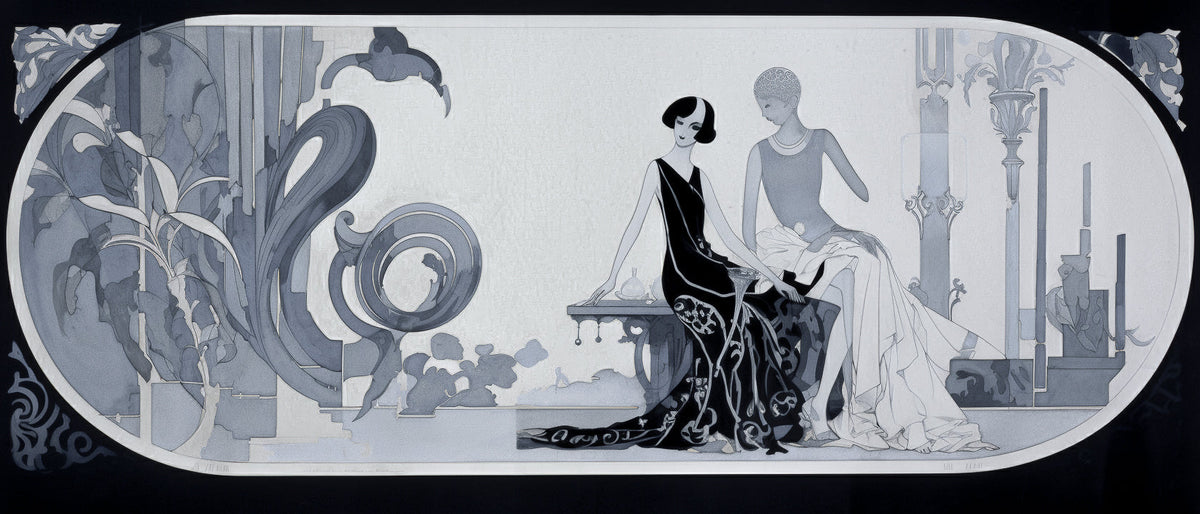
What Makes Chypre Perfumes Last? The Science and Sensory Magic Behind This Timeless Fragrance
|
|
Time to read 9 min


|
|
Time to read 9 min
The distinctive character of chypre perfume comes from its perfect balance of citrus top notes and woody base notes. Named after the island of Cyprus (Chypre in French), these compositions represent one of the most sophisticated and enduring fragrance families in perfumery. When exploring the world of luxury scents, chypre perfume often stands out for its complexity and depth.
But what exactly gives these perfumes their remarkable staying power? The answer lies in a perfect marriage of chemistry, artistry, and tradition that has evolved over centuries.
Chypre perfumes follow a three-tiered structure that creates their distinctive scent evolution:
Top Notes: The First Impression
The journey begins with bright, volatile compounds—primarily citrus elements like bergamot—that create an immediate impression. These molecules are lightweight (typically 136-154 g/mol) and evaporate quickly, lasting only 15-30 minutes on the skin.
Heart Notes: The Emotional Center
As top notes fade, the middle or heart notes emerge—often floral elements like rose or jasmine. These medium-weight molecules (170-200 g/mol) provide the fragrance’s character and typically last 2-4 hours.
Base Notes: The Lasting Signature
The foundation of any chypre perfume lies in its base notes—heavy, complex molecules exceeding 250 g/mol. These include oakmoss, patchouli, and labdanum, which can last 6-24 hours on the skin, creating that signature lingering quality.
When wearing a chypre fragrance, you’ll notice how the scent evolves beautifully throughout the day. This evolution isn’t random but carefully orchestrated through the selection and balancing of ingredients with different volatility rates.
While perfumers had been creating chypre-like compositions for centuries, the modern chypre perfume category was officially established in 1917 when François Coty released his groundbreaking creation simply named “Chypre.” This landmark fragrance codified the structure that would define the family: bergamot in the top, labdanum in the heart, and oakmoss in the base.
The market for niche fragrances has grown significantly as consumers seek more unique and personal scent experiences. Unlike mass-market options, niche fragrances often tell a story through their composition and presentation. Chypre structures have become particularly popular in the niche fragrance world because they offer perfumers a sophisticated framework for creative expression.
Bergamot, a citrus fruit resembling a small, bumpy lemon with a greenish tint, provides the characteristic bright opening of chypre perfumes. Its essential oil contains compounds like limonene and linalyl acetate that create a fresh, slightly floral citrus scent.
The appeal of natural perfume lies in its purity and connection to traditional perfumery practices. When bergamot is used in natural perfume creation, it’s often cold-pressed from the fruit’s peel to preserve its complex aromatic profile.
Oakmoss has historically been the defining base note of chypre perfumes. This lichen (not actually a moss) grows on oak trees and produces a rich, earthy, slightly sweet aroma due to compounds like evernic acid and atranorin.
However, regulatory changes have limited oakmoss use in modern perfumery due to potential allergens. This has led to significant innovation in the niche fragrance industry, with perfumers developing creative alternatives and modifications to maintain the chypre character while complying with regulations.
Labdanum resin, harvested from Cistus ladanifer shrubs, provides the warm, ambery heart of chypre compositions. Its complex molecular structure includes labdane diterpenes that create a rich, slightly sweet, and woody aroma.
Creating a natural perfume requires extensive knowledge of botanical ingredients and their interactions. Labdanum is particularly valued in natural perfumery for its fixative properties and rich, complex aroma that helps bind other ingredients together.
The concentration of aromatic compounds significantly impacts a perfume’s longevity. Chypre perfumes are often formulated at higher concentrations, enhancing their staying power:
Concentration Type |
Aromatic Compound % |
Primary Characteristics |
|---|---|---|
Parfum/Extrait |
15-30% |
Highest concentration, greatest longevity (6-24 hours), subtle diffusion |
Eau de Parfum |
8-15% |
Strong presence, good longevity (4-8 hours), moderate projection |
Eau de Toilette |
4-8% |
Lighter application, moderate longevity (2-4 hours), good projection |
Eau de Cologne |
2-4% |
Brief presence, minimal longevity (1-2 hours), immediate projection |
A truly exceptional luxury fragrance often features rare and precious natural ingredients. When these ingredients are formulated at higher concentrations, they create a more immersive and long-lasting scent experience.
Many consumers are turning to natural perfume options as they seek cleaner, more sustainable beauty products. The growing demand for non-toxic perfume reflects consumers’ increasing concern about ingredient safety.
Creating an effective non-toxic perfume requires finding natural alternatives to synthetic fixatives. This is particularly challenging with chypre structures, which traditionally rely on oakmoss—now restricted due to potential allergens.
Natural perfume oils provide a more concentrated and long-lasting scent experience compared to alcohol-based fragrances. Perfumers working with natural perfume oils must understand how different botanical extracts interact with each other to create a balanced composition that evolves beautifully on the skin.
Modern natural perfumery has embraced chypre structures with innovative approaches:
Using sustainable, ethically sourced botanical ingredients
Developing natural fixatives to replace synthetic options
Creating alcohol-free oil-based formulations for greater longevity
Focusing on the quality and purity of essential oils and absolutes
Each bottle of artisan perfume represents countless hours of careful formulation and testing. The beauty of artisan perfume lies in its uniqueness and the personal touch of its creator. Supporting artisan perfume makers helps preserve traditional perfumery techniques and knowledge.
Modern perfumery has embraced technology to enhance the performance of chypre compositions:
Molecular Modification
Chemists can now modify natural compounds to enhance stability and longevity while reducing allergenic potential—particularly important for oakmoss alternatives.
Microencapsulation
This technology encases fragrance molecules in microscopic shells that break open gradually, releasing scent over an extended period.
Computational Modeling
Advanced algorithms help predict how molecules will interact, allowing perfumers to create more stable and long-lasting compositions.
The experience of wearing a luxury fragrance extends beyond the scent to the entire presentation and story. Investing in a luxury fragrance means enjoying a carefully crafted olfactory journey. Modern chypre perfumes often tell complex stories through their evolution on the skin.
If you’ve ever wondered what is a chypre fragrance, it’s a perfume family characterized by a contrast between fresh citrus notes and a woody-mossy base. Understanding what is a chypre fragrance helps appreciate its sophisticated composition and enduring appeal.
The distinctive character of chypre perfume comes from its perfect balance of contrasting elements:
Brightness vs. Depth: The sparkling citrus top notes create a beautiful tension with the deep, earthy base.
Freshness vs. Warmth: Cool, refreshing elements play against warm, resinous components.
Simplicity vs. Complexity: The seemingly straightforward structure reveals increasing complexity as it develops.
This balance creates a sense of completeness that many other fragrance families lack. It’s like a perfectly composed piece of music with harmonizing high and low notes.
Consider your skin type: Dry skin may need richer, more concentrated formulations, while oily skin often holds fragrance longer.
Test before committing: Chypre perfumes evolve significantly on the skin, so always wear a sample for a full day before purchasing.
Start with modern interpretations: Contemporary chypres tend to be more approachable than vintage formulations.
Apply to pulse points where body heat will help diffuse the scent gradually
Layer with matching body products to extend wear time
Consider applying to clothes (test for staining first) for even longer-lasting scent
Chypre perfume represents one of the most enduring and sophisticated fragrance families in perfumery. Its remarkable longevity comes from a perfect balance of science and art—volatile molecules carefully arranged to create an evolving olfactory experience that can last from morning until night.
In today’s world of niche fragrances, chypre structures continue to inspire perfumers and delight fragrance enthusiasts. Whether in traditional formulations or modern natural perfume interpretations, the chypre family offers a depth and complexity that rewards those willing to explore beyond mainstream scents.
The next time you apply a chypre perfume, take a moment to appreciate the centuries of knowledge, the careful balance of ingredients, and the artistic vision that come together in that single spray—a true testament to the enduring magic of perfumery.
Kraft, P., Bajgrowicz, J. A., Denis, C., & Fráter, G. (2000). Odds and trends: Recent developments in the chemistry of odorants. Angewandte Chemie International Edition, 39(17), 2980-3010.
Turin, L., & Sanchez, T. (2008). Perfumes: The A-Z Guide. Profile Books.
Calkin, R. R., & Jellinek, J. S. (1994). Perfumery: Practice and principles. John Wiley & Sons.
Sell, C. (2006). The chemistry of fragrances: From perfumer to consumer. Royal Society of Chemistry.
Pybus, D. H., & Sell, C. S. (1999). The chemistry of fragrances. Royal Society of Chemistry.
Arctander, S. (1960). Perfume and flavor materials of natural origin. Allured Publishing Corporation.
Bauer, K., Garbe, D., & Surburg, H. (2008). Common fragrance and flavor materials: Preparation, properties and uses. John Wiley & Sons.
Burr, C. (2008). The perfect scent: A year inside the perfume industry in Paris and New York. Henry Holt and Company.
Aftel, M. (2004). Essence and alchemy: A natural history of perfume. Gibbs Smith.
International Fragrance Association. (2021). IFRA Standards. Retrieved from https://ifrafragrance.org/safe-use/standards-guidance
Firmenich. (2020). Sustainability Report 2020. Retrieved from https://www.firmenich.com/sustainability
Givaudan. (2021). 2020 Integrated Annual Report. Retrieved from https://www.givaudan.com/investors/online-annual-report-2020